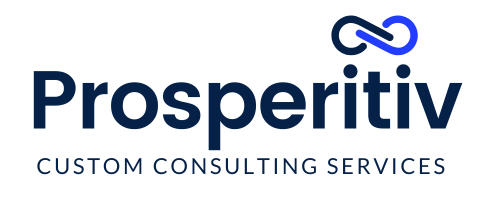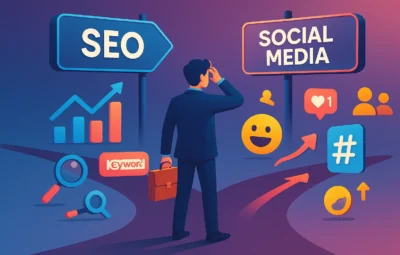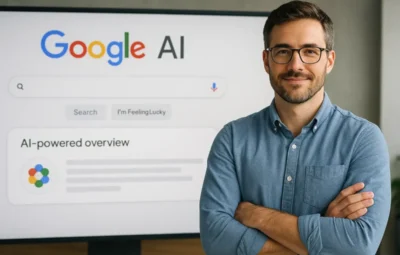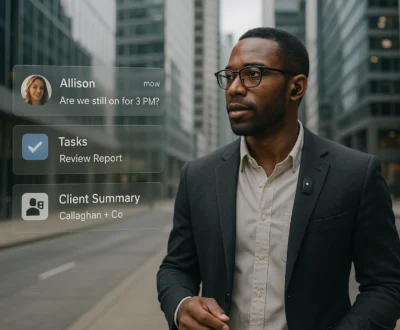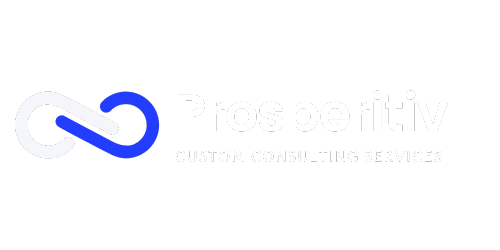Are AI Summaries Killing Your Traffic — or Creating a New Opportunity?
AI Summaries Are Already Changing Google Search: What You Need to Know (And Do About It)
Publishers and websites are sounding alarm bells. Google’s AI Overviews (sometimes called “AI summaries” or “AI-Mode summaries”) are showing up more often in search results. These often give users quick answers at the top of the results page. People are seeing enough info there that they don’t click through to the actual articles behind them. Several studies show click-through rates (CTR) dropping when AI Overviews appear.
That’s a problem especially if your business relies on traffic, ads, leads and subscriptions. But, there is also real opportunity here by making sure your business is one of the sources being quoted in AI summaries. More on the solutions later. First, let’s take a look at some of the real numbers.
How AI Summaries Are Cutting Into Online Traffic
According to a BBC report, media groups such as Reach and DMG Media have already seen click-through rates fall sharply as more users get the information they need without visiting the original articles. While this is understandably worrying for news outlets and businesses alike, it also opens the door to a different way of thinking: how companies can adapt their SEO, AIO (AI Overview optimisation), and GIO (Google Integrated Optimisation) strategies to turn summaries into an advantage rather than a threat.
Real Data: User Intent, SEO and AI Summaries
What the data really shows is a shift in how people are using Google. Instead of clicking through to check the details, many are happy with the short answer they see at the top inside AI summaries. That might mean fewer visits to your website, but it also highlights something important: Google’s AI has to pull those answers from somewhere.
- A Pew Research Center study found that for searches which trigger an AI summary, users clicked a standard result in only 8% of cases, versus 15% for queries without an AI summary (Search Engine Land)
- Also in that same study, when an AI summary appears, “search sessions end more often” (26% vs 16%). Meaning people are less likely to go deeper. (Search Engine Land)
- Another report (SMK / BrightEdge etc) saw search impressions rise by about 49% year-over-year, while click-through rates dropped nearly 30% since AI Overviews started being rolled out broadly (hireawriter.us)
- Additional data from Ahrefs, Amsive, SimilarWeb suggest that for pages / queries with AI Overviews, CTR is down on average by between 15%-35% (depending on niche, query type) compared to similar informational queries without summaries (Search Engine Roundtable)
These drops matter: fewer clicks = less traffic, fewer opportunities for conversions, subscriptions, ad revenue, etc.
Why This Isn’t Just a “Publishers’ Problem”
Even if you’re not a big media outlet, this trend affects many kinds of businesses:
- Content-led businesses (blogs, resource pages, whitepapers etc.)
- Ecommerce when there’s informational content (how to choose, comparisons, guides)
- B2B companies that use thought leadership, reports or case studies to attract leads
- Local businesses that rely on “how to”, “where to find”, “reviews” content
If Google or other search engines increasingly satisfy user intent via AI summaries rather than sending people through your site, then your content strategy needs to change, or you risk losing forward momentum.
What Google Says Matters
Google has published guidance that suggests many of the same fundamentals of “good SEO” still count. Among relevant advice:
- Use structured data (schema markup) matching what is visible on the page so Google can trust that what the AI “reads” is faithful.
- Make content clear, useful, with authority and trustworthiness. They emphasise expertise, freshness where appropriate.
So it’s not that the game has changed completely. It’s more that some of the “background work” you may have done or ignored before now matters a lot more.
What You Can Do: Actionable Ways to Adapt & Even Benefit
Here are steps you can take now. While some are small tweaks, others require strategy shifts but all are doable, even without a huge marketing budget.
| Area | What to Do | Why It Helps / What Outcome to Expect |
|---|---|---|
| 1. Content Structure & Readability |
|
Google’s AI pulls from sources that clearly surface answers. Clear structure increases your chances of being cited in AI summaries, which boosts brand visibility even if some clicks are reduced. |
| 2. Freshness, Expertise & Trust |
|
Fresh, credible content signals reliability to AI systems. It increases the likelihood of being cited and builds authority while reducing risks from inaccuracies that erode trust. |
| 3. Optimise for Featured Snippets & SERP Features |
|
Tactics that win Featured Snippets often align with what AI Overviews draw on. If you earn snippets, you’re better placed to be referenced in AI summaries as well. |
| 4. Use Structured Data & Markup |
|
Machine-readable context helps search systems understand and trust your content, improving eligibility for rich results and potential inclusion in summary sources. |
| 5. Monitor, Test & Adjust |
|
Iteration reveals what structure and tone perform best as Google evolves its AI features. Continuous testing keeps your content aligned with how answers are surfaced. |
| 6. Diversify Traffic & Engagement |
|
Owned and direct channels are less vulnerable to zero-click behaviour and reinforce brand loyalty so audiences return without relying solely on search. |
How Measuring Success Needs to Evolve
Traditional metrics (just ranking + organic traffic) are still needed but insufficient. Here’s what to add / emphasise:
- “Citation visibility”: Not just how often your page ranks, but how often it gets mentioned/cited by AI Overviews (even in the text, even without link clicks). That gives brand awareness.
- Click-through rate changes for queries with AI Overviews: Separate your keyword / query sets into “those with summaries” vs “those without” so you can see different performance.
- User behaviour: Are people reading less because they see summary and leave? Is bounce rate going up on pages that used to bring in traffic via search?
- Engagement beyond initial click: Do users arrive later from different paths (social, email, direct) because they saw you in AI? Are conversions staying steady even if raw traffic drops?
The Hidden SEO Risks When Optimising for AI Summaries
- Assuming that because your content ranks #1 you’re safe. Even top ranking pages lose CTR when AI Overviews appear above.
- Writing for keywords first, then figuring structure: structure + headings + clarity need to be baked in from the start.
- Doing schema or FAQ markup without making sure the visible content matches it. If the markup says one thing and the page shows another, that hurts credibility.
- Waiting passively for Google to “fix” or “balance” things. Yes, regulatory / industry pressure may lead to changes, but that’s not something you can rely on exclusively.
Case Example / Mini Scenario: AI Summaries Explained
Imagine a mid-sized B2B company (“TechCo”) that writes in-depth guides about “best practices for cloud migration”. Before AI Overviews, many people clicked from Google, read 2,000-word long-form guides. TechCo ranks well for many of those.
Now with AI Overviews (AI Summaries), people often search a question like “how do I migrate applications to cloud securely” and see a summary which pulls from multiple sources including TechCo. Because TechCo’s content is good but very long and buried, the summary draws a sentence or two from them but many users read the summary and don’t click. TechCo’s organic traffic drops significantly.
The screenshot below shows an example of what this type of search might look like for a real company, Sysdig.

What TechCo does to adapt:
- Review their most popular cloud migration articles and add a short “Key steps at a glance” section near the top, with bullet points.
- Revise headings to include actual user-style questions (“What steps are needed to secure app migration?”, “Which tools reduce risk in cloud migration?”).
- Add FAQ schema with well-defined question/answer pairs.
- Update the content with fresh references (recent case studies, new cloud tools) to show freshness.
- Monitor which queries are triggering summaries in Google search console or using SEO tools; for those queries, they compare what competitor content is being cited and adjust their content to match the format, tone, clarity of those (without copying).
- Meanwhile, they start encouraging more people to sign up for their newsletter, releasing exclusive guides or templates that aren’t summarised elsewhere, giving added value.
Result:
Over several months, even though click traffic via search queries with summaries still lags, they reclaim better CTR on queries where they’ve done these optimisations. They also retain their audience via direct channels, and brand perception improves (when people see them quoted or cited in summary panels, the authority increases).
The Big Picture: Why Working With the Right Partner Helps
This kind of AI summaries adaptation often requires more continuous iteration than what many companies are used to. That’s where having a marketing agency or business consultancy in your corner can be a major competitive advantage. A good partner should be:
- Transparent: they show the data, what tests were run, what changes they made, what worked / didn’t
- Fluid / flexible: ready to pivot formats, test content style, adjust strategy as Google changes its AI features
- Experienced: someone who already understands SEO + AI-driven trends, who has seen similar shifts before
Marketing agencies can help by doing things like:
- Audits of current content to see which keywords / content pieces are most impacted by AI summaries
- Mapping competitor content that is being cited to see what structural & stylistic differences exist
- Running A/B-style content tests (e.g. revised headings, bullet summaries, schema) to measure which format wins for specific queries
- Setting up dashboards / monitoring so you get early warning of drop-offs, and can respond rather than react
What You Should Do First (Your 30-Day Plan)
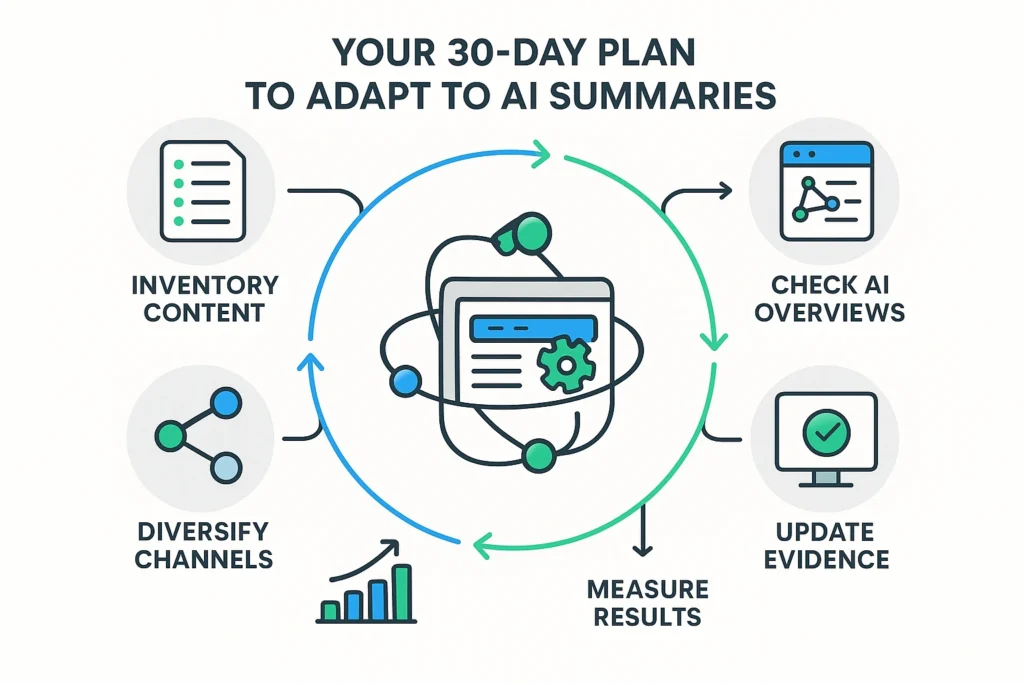
Here’s a suggested quick plan you could follow in the next month to start adapting:
- Inventory your content: find your top-traffic informational pages, keywords, long-form guides.
- For each, check whether their queries are triggering AI Overviews (use SEO tools, Google Search Console, perhaps third-party tools that track the appearance of AI summaries).
- Pick 2-3 pieces of content to optimise immediately: add summary or “key points” sections early; ensure headings map to user questions; apply or fix schema.
- Update evidence or freshness (stats, recent examples) for those pages.
- Set up measurement: CTR pre/post, time on page, bounce, maybe brand mention / citation tracking.
- Begin building or strengthening non-search channels (e.g. email list, community, social) to ensure you’re not totally dependent on search traffic.
Recommended: Google AI Mode and the Future of Search: A Complete Guide
Closing Thoughts on AI Summaries
AI summaries may feel like they’re pulling the rug out from under businesses that rely on search traffic, and the fears raised by publishers highlight just how disruptive the change can be. But the answer isn’t to panic but to adapt.
By structuring content for clarity, following SEO, AIO and GIO best practices, and building stronger direct connections with your audience, you can stay visible and credible even as search evolves. The real challenge is keeping up with these changes while still focusing on your core business.
Working with a transparent, flexible partner like Prosperitiv can help guide you through the shifts, keep you ahead of trends, and turn this new search landscape with AI summaries into a real opportunity for growth.
If your business positions itself as a trusted source that AI systems draw from rather than bypass, you’ll gain visibility in new places. Prosperitiv partners with you to adapt your SEO and content so that AI summaries work for you, not against you.
FAQS:
Click the + to read any answer or visit our most FAQ page to review the most frequently asked questions across all our Elite Locations.
If you click on a ‘Category’ or ‘Tag’ link, the page will ‘refresh’ and reload the page showing the top of the page first, you’ll then just need to scroll down to the FAQ section to see the results for the Category or Tag you selected.
Yes. While clicks may decrease, appearing as a cited source in an AI summary can build brand authority and trust. If your content is structured clearly, factually accurate, and regularly updated, it has a higher chance of being quoted by AI. This visibility can strengthen brand recognition and still drive qualified traffic.
AI summaries (also known as AI Overviews) provide users with quick answers directly in search results. This often reduces click-through rates, as people no longer need to visit the original site to get basic information. Studies show traffic drops ranging from 15% to nearly 90% depending on the sector and query type.
Focus on clear structure, question-based headings, concise answers near the top of the page, and schema markup that matches visible content. Keep content fresh with updated stats and examples, and diversify your channels (email, social, newsletters) so you’re not reliant solely on search traffic.
- AI, AIO, Digital Marketing, GIO, SEO
Recent Posts
Popular Posts
About us and this blog
We are a digital marketing company with a focus on helping our customers achieve great results across several key areas.
Request a free quote
We offer professional SEO services that help websites increase their organic search score drastically in order to compete for the highest rankings even when it comes to highly competitive keywords.
Subscribe to our newsletter!
More from our blog
See all postsRecent Posts
- Are AI Summaries Killing Your Traffic — or Creating a New Opportunity? September 11, 2025
- Synthetic Intelligence Is Coming. What SMEs Should Know August 29, 2025
- AI Smart Glasses Will Rewrite Marketing: Are You Ready for GEO? July 24, 2025
